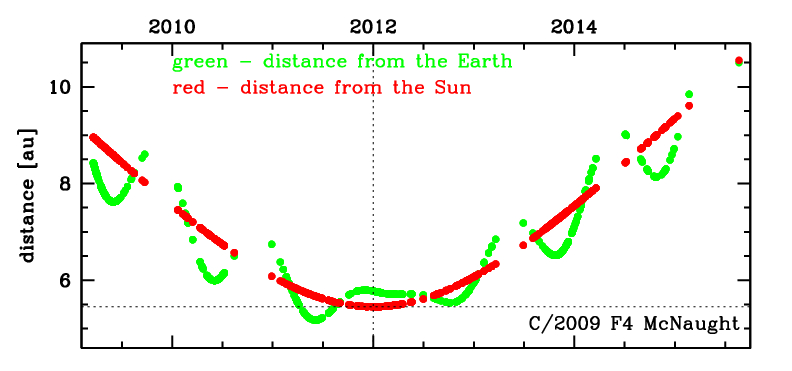C/2009 F4 McNaught
more info
Comet C/2009 F4 was discovered on 19 March 2009, that is 2.8 yr before perihelion passage, and next was observed 6.4 yr during seven oppositions in a range of heliocentric distances: 8.96 au – 5.455 au (perihelion) – 10.5 au.
Comet had its closest approach to the Earth on 3 June 2011 (5.179 au, almost seven months before perihelion).
NG orbits using full data-arc as well as using pre-perihelion data arc are determinable.
This Oort spike comet suffers a tiny planetary perturbations during its passage through the planetary system that lead to a more tight future orbit (see future barycentric orbit).
See also Królikowska and Dones 2023 and Królikowska and Dybczyński 2017.
Comet had its closest approach to the Earth on 3 June 2011 (5.179 au, almost seven months before perihelion).
NG orbits using full data-arc as well as using pre-perihelion data arc are determinable.
This Oort spike comet suffers a tiny planetary perturbations during its passage through the planetary system that lead to a more tight future orbit (see future barycentric orbit).
See also Królikowska and Dones 2023 and Królikowska and Dybczyński 2017.
| solution description | ||
|---|---|---|
| number of observations | 1204 | |
| data interval | 2009 03 19 – 2015 08 20 | |
| data type | perihelion within the observation arc (FULL) | |
| data arc selection | entire data set (STD) | |
| range of heliocentric distances | 8.96 au – 5.46 au (perihelion) – 10.5 au | |
| detectability of NG effects in the comet's motion | comet with determinable NG~orbit | |
| type of model of motion | GR - gravitational orbit | |
| data weighting | YES | |
| number of residuals | 2383 | |
| RMS [arcseconds] | 0.51 | |
| orbit quality class | 1a+ | |
| orbital elements (heliocentric ecliptic J2000) | ||
|---|---|---|
| Epoch | 2011 12 25 | |
| perihelion date | 2011 12 31.89245025 | ± 0.00020708 |
| perihelion distance [au] | 5.45486596 | ± 0.00000076 |
| eccentricity | 1.00159284 | ± 0.00000143 |
| argument of perihelion [°] | 260.383469 | ± 0.000015 |
| ascending node [°] | 53.584371 | ± 0.000004 |
| inclination [°] | 79.347586 | ± 0.000007 |
| reciprocal semi-major axis [10-6 au-1] | -292.00 | ± 0.26 |
